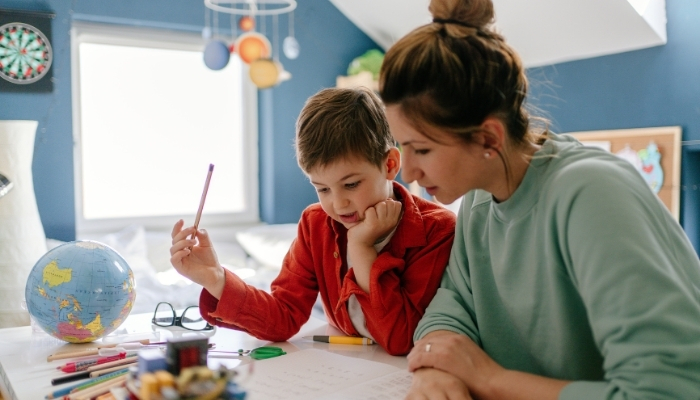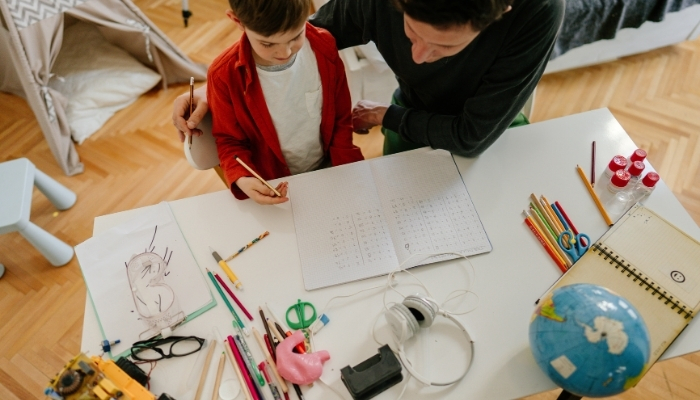Over 45,000 Australian children are now homeschooled, and that number keeps growing as parents search for a more personal, balanced way to help their children learn. You might be one of those parents quietly wondering if traditional schooling still fits your child. Maybe you’ve noticed them losing interest, feeling overwhelmed, or needing more time to explore what truly excites them.
If you’ve been thinking that learning should feel meaningful and not mechanical, you’re right. Getting started with homeschooling can feel both exciting and uncertain. There’s paperwork to understand, routines to build, and the constant question in your mind: Am I really ready for this? It’s a lot to take in, but the fact that you’re here means you already care deeply about your child’s growth, and that’s the most important part.
This guide is here to make the process simpler and more achievable. It will help you understand what homeschooling really involves and how to take the first steps with confidence.
Key Takeaways
-
Homeschooling success begins with clear planning, flexible routines, and realistic expectations that align with your child’s pace and personality.
-
Exploring different teaching methods helps you tailor learning to each learner rather than following a one-size-fits-all approach.
-
Avoid common mistakes like over-scheduling, ignoring self-care, or isolating from community support to maintain balance and motivation.
-
Social interaction and emotional growth are just as crucial as academics; structured group learning helps children thrive.
-
Platforms like FunFox strengthen your homeschool experience by combining expert guidance, small-group learning, and a supportive community.
What Homeschooling Really Means?
Homeschooling is an educational approach in which parents take an active role in guiding their child’s learning at home or in other environments outside traditional classrooms. It allows children to learn at their own pace, focusing on their individual strengths, interests, and learning styles. Instead of following a standard school timetable, homeschooling adapts to the child's and the family's rhythm.

The essence of homeschooling is personalized education. Contrary to common misconceptions, homeschooling does not mean a lack of social interaction. In fact, homeschooled children often engage in community activities, clubs, sports, and other group programs more than a regular school-going kid.
Homeschooling works best for families who value flexibility, individualized attention, and the ability to create a supportive learning environment. Parents do not need formal teaching credentials to succeed. Their role is to guide, encourage, and provide resources that help the child grow, fostering curiosity, confidence, and resilience along the way.
Benefits and Challenges of Homeschooling
Homeschooling can be one of the most rewarding decisions you make for your family. It gives you the chance to guide your child’s education in a way that truly fits their needs and your family’s lifestyle. Still, like any major commitment, it comes with both advantages and challenges that are worth knowing before you begin.
Benefits
-
Personalized learning: You get to teach your child in the way they learn best, be it through visuals, hands-on projects, or real-world examples. Lessons move at their own pace, not a classroom schedule.
-
Flexible routines: You decide when and how learning happens. This freedom helps reduce stress, creates more balance, and allows for travel or family time whenever it suits you.
-
Stronger family bonds: Spending more time together helps you understand your child on a deeper level and share their learning moments as they happen.
-
Safe learning environment: At home, your child can focus without the pressures or distractions often found in traditional schools.
Challenges
-
Time and energy demands: Teaching at home requires daily planning, patience, and consistency, as it’s a significant time commitment.
-
Financial impact: Curriculum materials and reduced work hours can affect the family budget, so planning helps.
-
Missing specialized facilities: You lack access to science labs, art studios, and sports fields that schools provide automatically. You must find creative solutions or join community programs to fill these gaps.
-
Occasional self-doubt: It’s normal to wonder if you’re doing enough. Connecting with other homeschooling families can make a big difference.
Every family faces these realities differently, but understanding both sides helps you prepare wisely and stay confident. Now that you know what to expect, let’s move on to how to get started with homeschooling and set up your first steps the right way.
Steps to Getting Started With Homeschooling
Starting homeschooling requires careful planning and preparation. These ten steps will guide you through the process from legal requirements to establishing your routine.

Step 1: Understand Legal Requirements and Registration
Each Australian state operates under different homeschooling regulations. You must register with your state education department before withdrawing your child from school. Children aged 6 to 17 must either be enrolled in school or have an approved homeschooling registration.
Registration essentials:
-
Complete application forms for each child
-
Submit learning plans aligned with your state's curriculum framework.
-
Provide identity documents, including birth certificates.
-
Demonstrate that you have parental responsibility and basic literacy skills.
In New South Wales, Victoria, and South Australia, education officials may conduct home visits to review your program. Queensland and Western Australia require annual reporting showing your child's progress. Registration periods vary from one to two years, depending on your state.
You do not need teaching qualifications to homeschool in Australia. However, you should have reading and writing skills equivalent to Year 10 level.
Step 2: Choose Your Educational Approach and Curriculum
You don't have to purchase expensive complete curriculum packages. Many families create their own using various resources. That said, your learning plan must align with the Australian Curriculum covering English, mathematics, science, humanities, and health.
Curriculum options to consider:
-
Distance education programs provide structured lessons with teacher support.
-
Self-created programs mix textbooks, workbooks, and online materials.
-
Autonomous learning, where you design custom lessons around your child's interests.
-
Hybrid approaches combining structured core subjects with flexible exploration.
Use the popular online platform FunFox to build multiple skills, such as reading and writing. Many families combine a structured curriculum for core subjects with flexible learning for others.
Your choice should match your teaching style and your child's learning preferences. Some children thrive with structured daily lessons, while others excel through project-based learning. You can start with one approach and switch if it does not work.
Remember, you can change your curriculum mid-year if needed. Flexibility is one of homeschooling's most significant advantages. Just document any changes in your records.
Step 3: Create a Personalized Learning Plan
Your learning plan outlines educational goals and how you will achieve them. State authorities require this document for approval of registration.
Include these elements:
-
Academic objectives for each subject area.
-
Teaching methods you will use.
-
Assessment strategies to measure progress.
-
Resources and materials needed.
-
Timeline for covering content.
Break down annual goals into manageable quarterly or monthly targets. For example, in mathematics, you might aim for mastery of addition and subtraction in term one, multiplication in term two, and so on.
Describe how you will teach each subject. Will you use textbooks, hands-on experiments, educational videos, or field trips? Be specific about your approach while leaving room for flexibility.
Plan how you will assess learning without traditional tests. Update your learning plan annually or when your approach changes significantly. Keep notes throughout the year about what works and what needs adjustment.
Step 4: Prepare Your Home Learning Environment
You do not need a dedicated classroom, but you do need organized learning spaces.
Set up practical learning zones:
-
A quiet study area with good lighting and minimal distractions.
-
Storage for books, supplies, and materials that children can access easily.
-
Display space for artwork, projects, and learning materials.
-
Comfortable reading nook with cushions and good lighting.
Keep supplies organized in bins or shelves. Stock basic items like pencils, paper, crayons, scissors, and glue. Add subject-specific materials as needed, such as science experiment supplies or art supplies.
Your home itself becomes a learning tool. The kitchen teaches measurements and chemistry, the garden demonstrates biology, and daily routines build life skills. Think beyond the traditional school setup.
Step 5: Gather Educational Resources and Support Materials
You need diverse materials covering different subjects and learning styles. Start with essentials and add resources as you discover what works.
Foundation resources include:
-
Core textbooks or workbooks for mathematics and English.
-
Library membership for books, audiobooks, and digital resources.
-
Age-appropriate fiction and non-fiction across various topics.
-
Manipulatives like blocks, counters, or fraction tiles for hands-on mathematics learning.
Free and affordable online resources have made homeschooling more accessible than ever. Your local library still matters as it offers digital learning portals, STEM kits, maker spaces, and free workshops designed for kids. Build a good connection with librarians; they’re often your best local learning partners.
Join online homeschooling communities and marketplaces where families share or sell used curriculum at lower prices. Facebook and Discord groups will help you connect with experienced parents who can recommend trusted materials and programs.
Instead of traditional encyclopedias or atlases, invest in high-quality digital learning tools. Use interactive reference apps like Britannica Kids and Google Arts & Culture to turn research into hands-on discovery.
Step 6: Track Progress and Assess Learning
You must document your child's learning for annual reporting requirements. Regular tracking also helps you identify areas needing attention before they become significant gaps.
Effective tracking approaches:
-
Daily or weekly logs recording activities and subjects covered.
-
Portfolios with work samples from each subject showing progress over time.
-
Photos of hands-on projects, field trips, and activities.
-
Reading lists documenting books completed with brief notes.
-
Assessment results from projects, presentations, or informal evaluations.
Assessment in homeschooling looks different from school testing. Use conversations, project presentations, or practical demonstrations. Watch for your child's ability to apply concepts in real situations rather than just memorizing information.
Create simple checklists or rubrics for major projects or units. This clarifies expectations for your child while helping you evaluate objectively. Involve your child in self-assessment to develop metacognitive skills that support lifelong learning.
Step 7: Consider Costs and Budgeting
Homeschooling costs vary widely based on your choices. Planning your budget prevents financial stress and helps you make informed decisions about resources and approaches.
Typical homeschooling expenses include:
-
Curriculum and learning materials: Choose programs that cover core subjects efficiently rather than piecing together multiple smaller ones.
-
Supplies and equipment: Set aside funds for notebooks, stationery, and digital tools like a tablet or laptop that will last for several years.
-
Extracurriculars and experiences: Include music, art, or sports activities that help your child develop beyond academics.
-
Educational outings: Plan visits to museums, workshops, and community events, many of which offer reduced homeschool rates or free days.
-
Technology costs: Reliable internet and learning software are essential parts of modern homeschooling.
Tips to manage costs wisely:
-
Track expenses monthly so you can adjust if something runs over budget.
-
Make the most of free library resources, including digital books, study kits, and children’s programs.
-
Join local homeschool groups to share or exchange materials with other families.
-
Watch for community programs that offer free or discounted learning opportunities for homeschoolers.
-
Explore available state-level allowances or tax benefits that can offset educational expenses.
Step 8: Join Support Networks and Groups
Connecting with other homeschooling families provides invaluable support, resources, and friendship. You need a community to sustain this journey long-term.
Homeschooling is easier and more enjoyable when you’re not doing it alone. Connecting with other homeschooling families gives you encouragement, fresh ideas, and a sense of belonging that keeps you motivated long term.
You can find support through:
-
Local homeschool groups that organize park days, field trips, and meetups for both parents and kids.
-
Online communities where families share tips, lesson ideas, and authentic experiences.
-
State or regional associations that provide legal guidance, workshops, and resources.
-
Subject-based or co-op classes where small groups of children learn together under shared guidance.
-
Special interest groups that connect families with similar values or teaching approaches.
These communities not only give your child social interaction and friendship but also offer you practical help, from curriculum recommendations to emotional support on challenging days. Many groups even collaborate for discounts on learning programs and events, helping you save while staying connected.
Step 9: Ensure Socialization and Extracurricular Opportunities
Your child needs regular peer interaction and opportunities to develop interests beyond academics. Active planning makes this happen instead of hoping it occurs naturally.
You can support healthy social development through:
-
Community sports, dance, or martial arts programs.
-
Music, art, or drama classes that encourage teamwork and creativity.
-
Volunteer activities and youth groups that teach responsibility and cooperation.
-
Regular playdates with neighborhood friends.
Social experiences give children the chance to practice what they learn in real-world settings. Studies show that learning alongside peers helps children develop higher-level thinking and problem-solving skills.
Step 10: Understand Pathways to Further Education
Homeschooling prepares students for a wide range of future opportunities. With proper planning, your child can pursue university, TAFE, or vocational education just like students in traditional schools.
To stay prepared:
-
Research university and TAFE entry options early to know what documentation or assessments are required.
-
Keep clear records of your child’s work, including projects, certificates, and reports.
-
Consider enrolling in a few accredited subjects in the senior years to receive recognized transcripts.
-
Encourage independent study habits and critical thinking skills that universities value.
-
Connect with homeschool graduates who have already taken this path for practical insight.
Most universities now accept homeschooled students through portfolio reviews or alternative pathways. In fact, many homeschool graduates adapt easily to higher education because they are used to managing their time and taking ownership of their learning.
Also Read: The Complete Guide to Silent Reading Fluency for Children
Types of Homeschooling Methods and Styles You Can Explore
Every family has its own rhythm, and the beauty of homeschooling is that you can choose an approach that fits yours. Understanding the primary methods helps you decide how your child learns best and what feels realistic for your household.

Here are the most common styles you can explore:
Classical Education
If you value structure and academic depth, this approach builds learning in three stages: foundational knowledge, logical thinking, and effective communication. It uses literature, history, and writing to shape clear thinkers and confident communicators.
Charlotte Mason Method
This method brings learning to life through quality books, storytelling, and time outdoors. Instead of long lessons or heavy worksheets, your child reads engaging “living books,” explores nature, and learns to express ideas clearly. It’s perfect if you want a gentle, literature-rich education.
Montessori Approach
Montessori encourages independence and curiosity. Your child learns through hands-on activities using real tools and materials, working at their own pace. It’s ideal for younger children who thrive on movement, choice, and practical learning.
Unschooling
In this child-led approach, learning grows naturally from curiosity. Here, your child learns by exploring interests, asking questions, and engaging with real-world experiences. It suits families who trust the learning process and enjoy a flexible, discovery-based style.
Unit Studies
If your child loves delving deeply into topics, this method combines subjects around a single theme. For example, when learning about space, they might read science stories, build models, and explore math through planetary measurements. It makes learning feel connected and meaningful.
Eclectic Homeschooling
Many families mix different methods. You might use structured lessons for math, Charlotte Mason for reading, and hands-on exploration for science. This flexible approach grows with your family.
Choosing a method is all about discovering what fits your family’s rhythm. Try one approach, observe what works, and don’t hesitate to blend styles. As your confidence grows, your homeschooling style will evolve naturally.
Also Read: Fun Ways to Teach Writing Letters That Make Learning Enjoyable
Common Mistakes to Avoid When Starting Out
New homeschoolers make predictable mistakes, creating unnecessary stress. Learning from others helps you avoid these pitfalls.

Trying to Replicate Traditional School at Home
It’s tempting to copy the school structure with desks, rigid schedules, and long lessons, but homeschooling works best when it doesn’t look like a classroom.
To avoid this mistake:
-
Focus on understanding rather than rigid “school hours.”
-
Use short, focused lessons and flexible breaks.
-
Adjust your teaching pace to match your child’s readiness.
-
Drop methods that create tension and replace them with approaches your child enjoys.
Overloading the Schedule
New homeschoolers often try to fit in too many classes, activities, and subjects. This leads to burnout for both you and your child.
To avoid this mistake:
-
Start small with core subjects and a few meaningful activities.
-
Keep some unstructured time each day for creativity or rest.
-
Review your schedule every few weeks and remove anything causing stress.
Ignoring Your Child’s Learning Pace
Comparing your child to others or to traditional grade levels only builds pressure. Every learner progresses differently.
To avoid this mistake:
-
Focus on steady progress instead of rushing through material.
-
Recognize strengths and weaknesses without judgment.
-
Celebrate growth, even small wins, to build confidence.
Forgetting Parent Self-Care
Homeschooling requires patience and consistency, and that’s hard to maintain without taking care of yourself.
To avoid this mistake:
-
Schedule regular personal breaks, even short ones.
-
Share responsibilities with your partner or family members.
-
Set realistic expectations for housework and routines.
Overlooking the Social and Emotional Side of Learning
Homeschooling can meet academic goals, but emotional growth and peer interaction need equal attention. Without planned social experiences, children may feel lonely or disconnected.
To avoid this mistake:
-
Create regular opportunities for group learning, clubs, and community activities.
-
Encourage friendships through consistent social interactions.
-
Involve your child in group projects that build teamwork and communication.
Social connection is essential for confidence and emotional health. If this feels like the most challenging part to manage, structured small-group programs with qualified teachers can bridge the gap. They combine guided learning with peer collaboration, helping children grow both academically and socially.
This is where a structured support program becomes a practical solution for you if you want support, connection, and expert-led learning experiences that your children will enjoy.
Also Read: 25+ Guided Reading Games for Kids with Practical Tips for Success.
Build Confident, Connected Learners with FunFox
After understanding homeschooling’s benefits and challenges, one concern remains: how to balance expert teaching with meaningful peer connection. Many parents worry their children might miss structured guidance or the joy of learning alongside others. That’s precisely where FunFox steps in, combining professional instruction with the social and emotional benefits of group learning.
True to its name, FunFox ensures fun stays at the heart of education. Every program is designed to make learning engaging, purposeful, and community-driven, giving your child the motivation and support they need to thrive.
Here’s how FunFox supports homeschooling families:
-
Small group classes that foster real friendships and collaboration, helping children feel connected while learning at their own pace.
-
Expert-led teaching by trained educators who guide literacy development with patience, precision, and encouragement.
-
The Writers Club builds strong writing foundations and creative confidence through interactive lessons and personalized feedback.
-
The Readers Club turns reading into a shared experience where children discuss stories, improve comprehension, and gain fluency together.
-
Integrated feedback during lessons so children improve instantly, preventing frustration and reinforcing positive learning habits.
-
Bonus NAPLAN and Selective School Booster programs are included at no extra cost, supporting your child’s academic confidence in key assessment areas.
-
Affordable, flexible online format that fits seamlessly into your homeschooling schedule without compromising quality or connection.
-
Community support for parents, offering reassurance that your child is on track and thriving both academically and socially.
FunFox bridges the gap between independent homeschooling and structured classroom learning. It gives your child the benefit of qualified teachers, peer interaction, and guided progress, while you maintain the freedom and flexibility that make homeschooling so rewarding.
Conclusion
Homeschooling is a choice that requires courage and planning, and, when done well, rewards both you and your child with a meaningful learning experience. If you want help making the social and professional pieces fall into place without losing your freedom to teach the way you believe is best, consider trying a structured, small-group program like FunFox. It is an easy way to add expert-led literacy instruction, regular peer interaction, and practical feedback while you keep control of the rest of your child’s learning.
Explore FunFox’s classes and see how a focused, community-based program can fit into your homeschool plan. Book a trial class now!
FAQ’s
1. What is the biggest disadvantage of homeschooling?
The biggest disadvantage is the significant time and energy parents must invest in planning, teaching, and maintaining consistency while balancing household and personal responsibilities.
2. Does Harvard accept homeschoolers?
Yes, Harvard accepts homeschoolers who meet admission requirements. Applicants are evaluated through academic records, standardized test results, essays, and demonstrated readiness for college-level work.
3. What is the best way to start homeschooling?
Begin by researching state requirements, setting clear learning goals, choosing an approach that fits your child’s needs, and creating a flexible routine supported by reliable educational resources.
4. What is the most successful homeschool method?
The most successful method varies from child to child. Many families prefer a blended approach that combines structure for core subjects with flexibility for creativity, exploration, and personalized learning.















